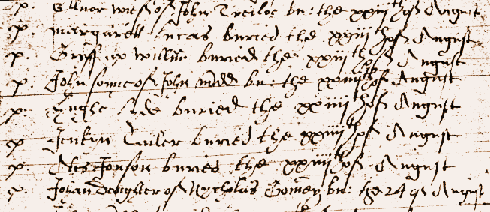
The Plague in Presteigne 2
The summer epidemics
Evidence of the parish registers
The bubonic plague outbreaks that swept England and Wales in
the 14th century ![]() returned at various
dates in the following centuries. There is evidence from the
parish registers, which by then had to denote plague deaths with
the letter "p" beside the names, that Presteigne was
visited by plague epidemics in 1593, 1610, and 1636. There may
have been less serious outbreaks at other times as well, when
the numbers of burials in the locality were unusually high.
returned at various
dates in the following centuries. There is evidence from the
parish registers, which by then had to denote plague deaths with
the letter "p" beside the names, that Presteigne was
visited by plague epidemics in 1593, 1610, and 1636. There may
have been less serious outbreaks at other times as well, when
the numbers of burials in the locality were unusually high.
Because the rat fleas which spread the epidemics hibernated in the winter, the plagues were at their very worst in the summer. At the peak of the epidemic in July 1593, twelve victims of the plague were buried at Presteigne in one day - a large number for a small town. About 50 deaths in one year was around the normal level at the time, but more than 380 died in 1593 and most of these deaths were due to the epidemic of that year.
Entries recording burials of
plague victims in the Presteigne
parish register
Summer 1593
Reproduced with acknowledgements to
the Parochial Church
Council of
St Andrew's

Presteigne gained an unwelcome reputation as a plague town at this time, and the outbreaks had a devastating effect on the local economy. There were no effective treatments known, despite an abundance of quack remedies and superstitions.
The disease affected rich and poor alike, and rapidly spread through families and households. Other communities were, quite understandably, unwilling to admit strangers for fear of the plague.
There are 3 pages on the plague in Presteigne. Use the box links below to view the other pages.